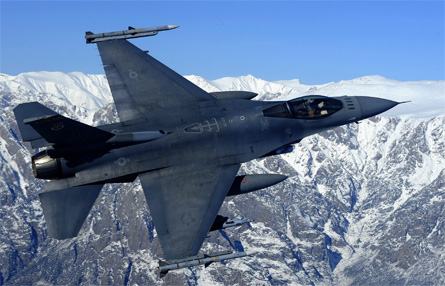The US Air Force has taken the first public step towards upgrading hundreds of Lockheed Martin F-16s with active electronically scanned array (AESA) radars.
The Aeronautical Systems Center (ASC) published a six-page request for information in late June, asking suppliers for information about options for upgrading between 300 and 600 later-model F-16s from 2017.
The air force excluded foreign suppliers because of security concerns, in a move which is likely to limit its options to the Northrop Grumman scaleable agile beam radar and Raytheon advanced combat radar (RACR).
Both systems have been in development for at least three years in anticipation of USAF's interest.
However, the service has also left the door open to possibly buying an all-new AESA radar to replace the Northrop APG-68(V)1 on F-16 Block 40/42s and APG-68(V)5 on Block 50/52s.
 |
|---|
© Rex Features |
The air force "prefers an 'off-the-shelf' solution", the ASC notice says, but "a new system design shall not be precluded, if that radar system can be accomplished within the objective time parameters".
Jim Hvizd, Raytheon vice-president of international strategy and business development, said the company had been anticipating such a request "at some point".
"This is the opening round of the services starting the dialogue with industry," Hvizd said.
Northrop officials did not immediately respond to requests for comment.
The numbers of F-16s involved in the proposed radar modernisation programme are "not a surprise", Hvizd said, but Raytheon considers them a starting point for discussion, and could be reduced.
The actual number is likely be driven by two factors, he said. First, the air force has to determine how many F-16s will survive beyond 2017. Earlier this year, the service commissioned Lockheed to launch a lifecycle fatigue test on an F-16.
Initial results will not be available for two more years, and only then will the USAF understand how many airframes are capable of enduring, and for how long.
The other issue that will drive the numbers of AESA retrofit orders is budget-related.
"There are still big questions about funding," Hvizd said. "I can't speculate, but we're all a little nervous."
Meanwhile, Raytheon's focus has turned towards possible international customers, including some buyers that do not have the luxury of waiting several years for the USAF to decide, he said.
Raytheon has previously received clearance to market its RACR design to Greece and South Korea.
Meanwhile, eastern European countries, such as Poland, Bulgaria and Romania, are discussing a joint modernisation programme if used F-16 sales are approved by the US government to the latter two countries, Hvizd said.
Source: Flight International























